Rosemary is easy to care for and can grow just about anywhere. In this post, I’ll show you all you need to know in order to have the best success, and biggest yields.

If you want to try growing herbs in your garden, then rosemary is a great choice. This versatile plant can be grown in a pot or the ground, and it requires very little care.
The best part about growing rosemary is being able to grab a fresh sprig whenever you need some for a recipe. It’s delicious in culinary dishes, and there are tons of uses for it.
Plus, when you grow your own, you’ll never have to buy it from the store again! So, if you’re ready to learn how to take care of rosemary, then keep reading this complete growing guide.
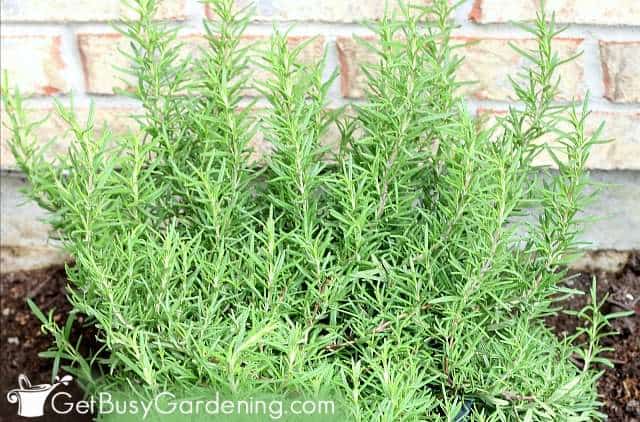
Rosemary Plant Care Overview
| Scientific name: | Salvia rosmarinus |
| Classification: | Herb |
| Common names: | Rosemary |
| Hardiness: | Zones 7-10 |
| Temperature: | 55-80°F |
| Flowers: | White, blue, or pink, blooms repeatedly |
| Light: | Full sun to partial shade |
| Water: | Allow soil to dry between waterings, do not overwater |
| Humidity: | Little to none |
| Fertilizer: | General purpose plant food in spring and summer |
| Soil: | Fast-draining, sandy soil |
| Common pests: | Aphids, spider mites, mealybugs |
Information About Rosemary
Rosemary (Salvia rosmarinus) is a perennial herb that is native to the Mediterranean, and a member of the mint family.
Northern gardeners might be surprised to learn that it can live for many years. In fact, it’s commonly used as a border shrub in warmer areas, where it stays evergreen year round.
Hardiness
All types of rosemary bushes are evergreen perennial plants that can live for many years in the right climate.
This temperate specimen is hardy in growing zones 7 through 10, which means only a small portion of the southern US can leave it outdoors year-round.
The rest of us must grow it as an annual or overwinter it indoors in order to enjoy the fresh flavor in winter dishes. Fortunately, it makes a lovely and very fragrant indoor plant.
How Does Rosemary Grow?
Rosemary grows as a compact woody shrub. Tough all parts of the plant are technically edible, we usually only eat the leaves and tender new shoots (sprigs) that form at the tips of the branches.
Different Types of Rosemary
In general, there are two types of rosemary you can grow: upright and creeping. Both varieties can be used as a culinary herb, as well as for decorative foliage.
They can be sold under several different names, but the characteristics described below should help you distinguish between the two.
- Upright Rosemary – This elegant shrub has a narrow grayish needle-like foliage with beautiful blue flowers. In the ideal climate, upright rosemary can grow to be as tall as 4-feet, with a spread of 3-feet.
- Creeping Rosemary – Creeping rosemary has an entirely different growth habit, but it still delivers the same pungent flavor. This variety is more commonly found trailing from terraced and raised beds, or as a ground cover in the garden.
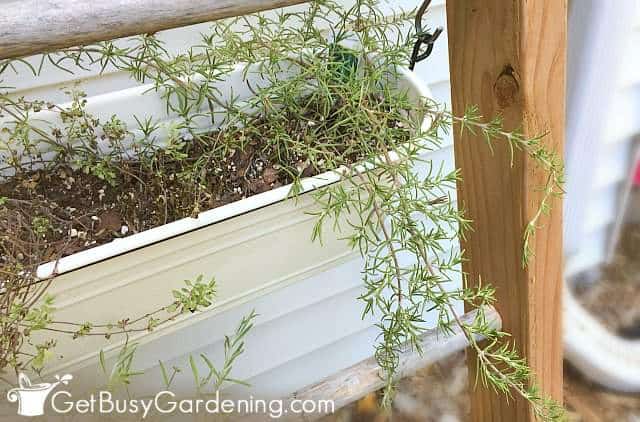
How To Grow Rosemary
Although there are two different types of rosemary plant, their basic care and growing requirements are the same. So, you can use the following instructions for both.
Where To Grow Rosemary
The best place to grow rosemary is in an area of your garden that gets full sun, and has fast draining, alkaline soil.
If you live in a warm climate, then make sure to give your plants adequate space. They don’t like to be overcrowded.
It also grows very well in containers, as long as the pot has drainage holes, and the soil does not hold water. When you grow it in a pot, you can easily bring it indoors for the winter.
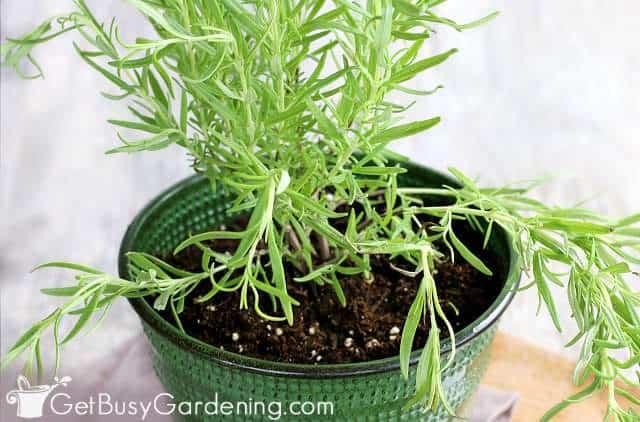
When To Plant Rosemary
Rosemary thrives in warm summer weather. So, it’s best to wait until all chance of frost has passed before planting it into your garden. If you live in a warm area, the best time to plant it is in the spring or fall.
If you plan to put it in a container, then you can start it much earlier. Just be sure to protect it from freezing temperatures in early spring.
Rosemary Plant Care & Growing Tips
For the most part, a rosemary plant is very easy to care for. Though they require very little maintenance, there are definitely some things you need to know in order to keep them growing their best. Below are all the details you need.
Sunlight
Rosemary needs 6 to 8 hours of sun per day in order to thrive. It will tolerate a partial shade location, but it won’t grow as fast.
Adequate sunlight is rarely an issue outdoors, but it can be difficult to provide enough light indoors. So, if you plan on keeping it inside for an extended period, then be sure to use a grow light.
Related Post: 15 Herbs To Grow In Your Shade Garden
Temperature
Though rosemary can survive short periods of freezing temperatures, it grows best when kept between 55-80°F.
It can handle the heat, and actually does very well in hot, arid climates. On the other hand, it does not love the cold.
So if your forecast calls for frost or a short burst of freezing weather, either move it indoors, or cover it to protect the foliage from damage.
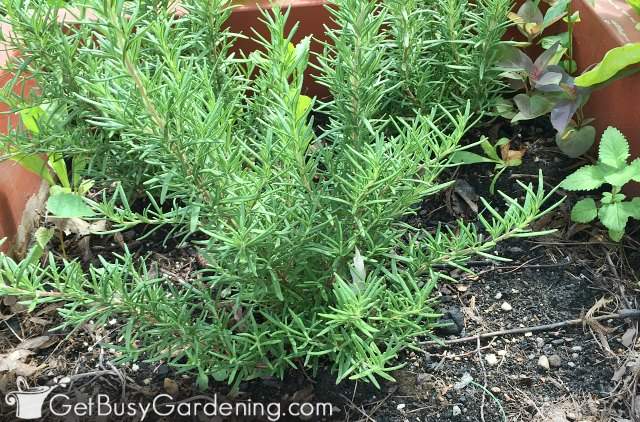
Watering
Whether growing indoors or out, rosemary does not need a lot of water. It won’t tolerate wet feet for long, so be sure to keep the soil on the dry side.
To ensure you never overwater, allow the soil to dry at least one inch down. But never let it dry out to the point where the leaves start shriveling or wilting.
If you’re unsure or you struggle with this, an inexpensive moisture gauge is a great tool that will help you get it perfect every time.
Soil
Rosemary grows best in well drained soil that has been amended with rich, organic ingredients, like worm castings or compost.
They also prefer it alkaline, so use a pH probe to test it, and add garden lime to neutralize the acidity if necessary.
They do not like wet roots, and won’t tolerate soggy soil for long. So amend outdoor beds with sand or perlite. Or use a high-quality mix in your containers.
Fertilizer
Regular fertilizer is not a necessary part of rosemary care because it’s not a heavy feeder. But like any other plant, it will benefit from being fed once in a while, especially in a container.
You can apply a granular fertilizer to the soil at planting time, then again monthly through the summer months. Or use a half strength liquid one (like compost tea or fish emulsion) weekly.
Using a foliar spray mid-season will also help to keep them happy and healthy. Learn more about fertilizing herbs here.
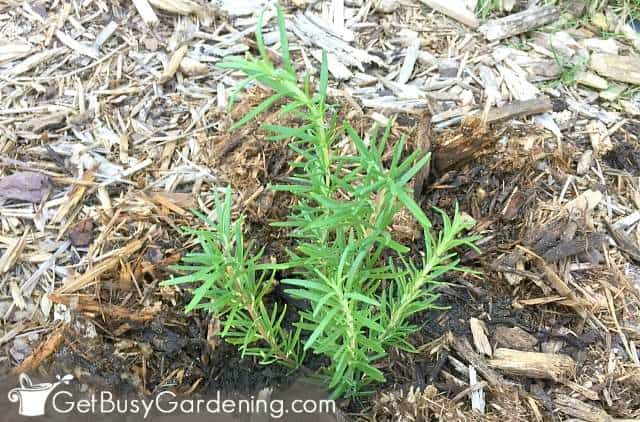
Pruning
Though regular pruning isn’t a required part of their care, your rosemary bush will definitely benefit from it. If you live in a warm climate, it will help to keep your shrub healthy, and rejuvenate it.
Doing so will not only allow you to control the shape and size, it will also encourage branching. Which means a bigger bounty for you!
But, to ensure that it replaces its growth, don’t trim off more than one-third of the plant at any given time. Learn exactly how to prune it here.
Pest Control
When given the proper care, rosemary rarely has any pest issues. But sometimes aphids or spider mites can become a problem, especially indoors.
Bugs can be controlled with an insecticidal soap spray. Or make your own by mixing one liter of water with a teaspoon of baking soda, and five drops of mild liquid soap.
Disease Control
Unfortunately, rosemary can be susceptible to powdery mildew. The best way to prevent it is to make sure that there is adequate spacing and airflow around each shrub.
Check regularly for signs of powdery mildew. If you spot some, you can treat the foliage with a diluted solution of one part milk to five parts water, or try an organic fungicide.
Then trim off the affected parts. If you’re growing rosemary indoors, place it in a sunny window to activate the milk solution.
Tips For Harvesting Rosemary
Picking rosemary is just as easy as growing and caring for it. The stems can be snipped off through the summer, and into the fall and winter in warm areas as needed.
The oils in the leaves are the source of the characteristic flavor, so any of the woody branches should be discarded before use.
Snipping the youngest stems and leaves will give you the freshest taste. Learn exactly when and how to harvest it here.
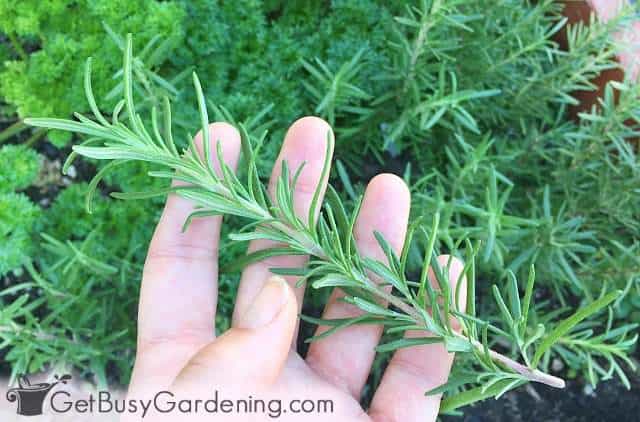
Rosemary Propagation Tips
Propagation can be done from either seeds or cuttings. Rooting the stem cuttings is the best way to get a sizable plant the fastest.
It takes quite some time for it to reach a mature size from seeds. So if you plan to try, start them at least ten weeks before your last frost date.
FAQs About Growing Rosemary
In this section, I will answer some of the most commonly asked questions about growing rosemary. If you have a question that isn’t answered here, ask it in the comments.
Is rosemary easy to grow?
Yes, rosemary is easy to grow as long as you give it the proper care. It likes heat, sun, fast-draining soil and the occasional pruning to stay healthy and thrive.
Does rosemary come back every year?
Rosemary will come back every year if you live in zones 7-10. If you are somewhere colder than that, you can overwinter it indoors, and keep it growing for many years.
Where does rosemary grow best?
Rosemary grows best in a sunny and warm location that has well-draining alkaline soil. As long as these basic care needs are met, it does equally well in a container as it does in the garden.
Why do my rosemary plants keep dying?
If your rosemary plants keep dying, it is most commonly caused by improper watering. Keeping the soil too wet will cause the roots to rot, but if it dries out too much, then the plant could also die. Keep it only slightly moist, but never allow it to dry out completely.
Can rosemary survive the winter?
Yes, rosemary can survive the winter in zones 7-10, or when kept indoors as a houseplant during freezing weather.
Can you grow rosemary indoors?
You can grow rosemary indoors quite easily. But it needs 6-8 hours of bright light, which can be difficult to achieve. Even a sunny window may not be enough, especially during the winter. So you’ll likely need to add a grow light.
Growing rosemary is easy, and requires very little care. Not only is it delicious, but it makes a beautiful evergreen shrub or houseplant. Now that you know all the details about their care, you can enjoy the fresh flavor whenever you want!
More About Growing Herbs
- How To Grow Basil: The Ultimate Guide
- How To Grow Stevia At Home
- 15 Perennial Herbs To Grow In Your Garden
- 11 Easy Herbs To Grow In Your Garden
- How To Grow Herbs Indoors: The Ultimate Guide
- How To Grow Ginger Root Indoors Or Outside
Share your plant care tips for growing rosemary in the comments section below.



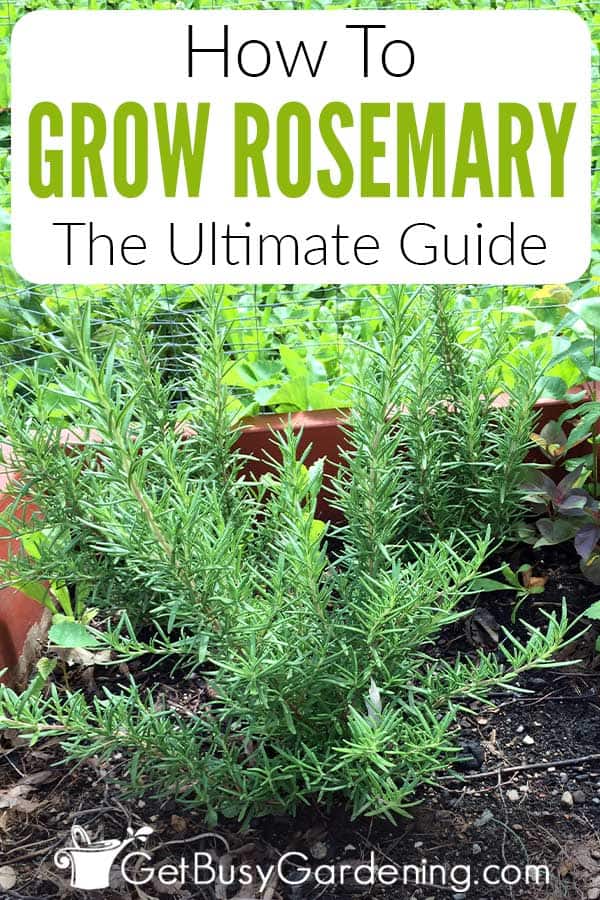
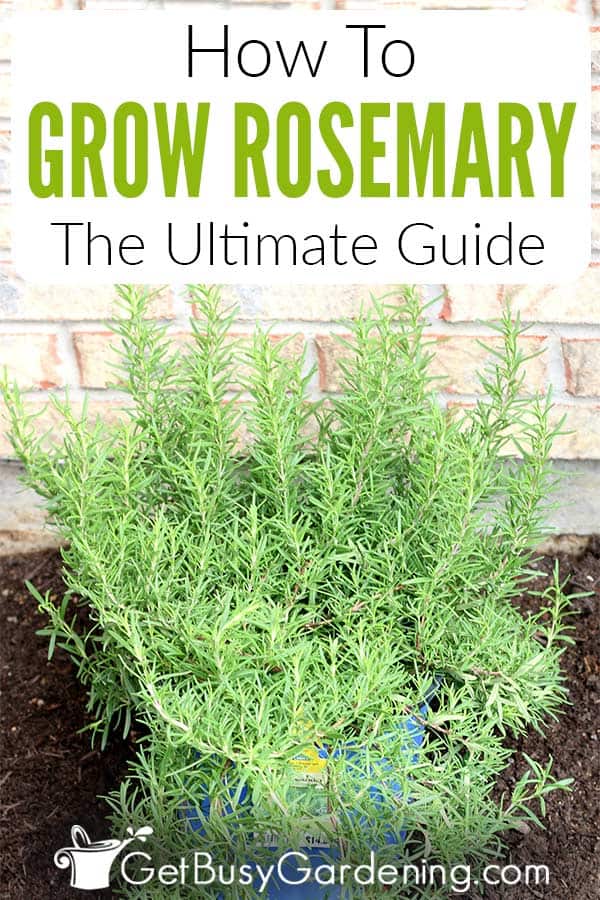
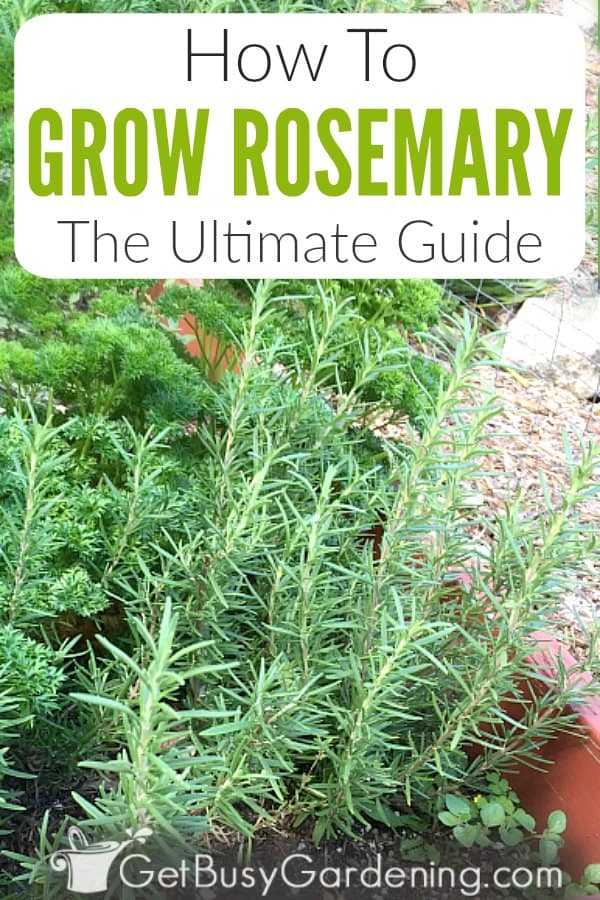


James Herronson says
Should I cut off a little bit of rosemary every time I need it? Or should I cut a big stem, dry it and use it for a long time without cutting the plant?
Amy Andrychowicz says
You could do it either way. Consistent harvesting will encourage branching, giving you a fuller plant (and more rosemary!). I like to harvest fresh rosemary right from the plant as I need it. When you dry it, it does lose some flavor, but it’s still great to use it to fill your spice rack! 🙂
Shannon Cowan from Eartheasy says
I’ve found in my growing zone that Rosemary does best up against the house on the south side. Even though we’re in zone 8, a cold snap can kill off exposed plants. Two years ago I experimented, planting one on each side of the house. Our south-sided rosemary (with some shelter) made it through and is thriving. The other one died. Sometimes location is enough to make the difference between success and failure.
Amy Andrychowicz says
Yes, that is very true! Glad to hear you found the perfect little micro-climate for growing rosemary. You’re lucky, I wish I could grow it year-round here in MN. 🙂